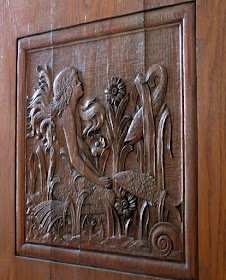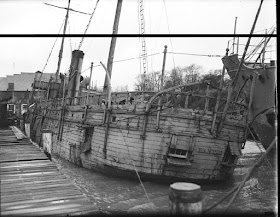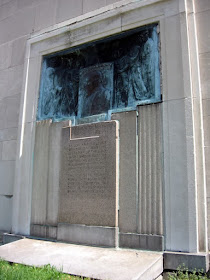Standing next to the Belle Isle Bridge, on the opposite shore from the Detroit Boat Club lays the Brodhead Naval Armory.
The four Pewabic tile medallions across the front here represent each of the armed services affiliated with sea duty, I presume the Navy, Marines, Coast Guard, and Merchant Marine:
Though Detroit lies hundreds of miles from the ocean, naval training there dates back to the late 1880s. At that time, several seacoast and Great Lakes states formed naval militias, the forerunners of the U.S. Naval Reserve and the U.S. Marine Corps Reserve. Michigan's naval militia began in 1893, and quickly developed into a popular pursuit for wealthy citizens. Though jokingly referred to as the "Millionaire's Navy," the Detroit reservists proved their worth in the Spanish American War and World War I. By 1929, membership had swelled to over 600 men, a number too large for the existing armory. The state and city agreed to appropriate $375,000 for a bigger building to stand at the foot of the bridge leading to Belle Isle.
Combining the vertical and streamlined characteristics of the era's Art Deco and Art Moderne styles, the new Detroit Naval Armory opened in October 1930 with a gala celebration. In addition to value as a training facility, it quickly became the premier civic event site of 1930s Detroit. The Armory's huge indoor drill floor was rented to host dances and USO mixers, auto shows, and political and sporting events. It was here in 1932 that future heavyweight champion Joe Louis fought his first career bout—a two-round loss. In coming years the Works Progress Administration (WPA) funded numerous additions of Depression era art to the building, including three murals, plaster carvings, and extensive wood carvings. With the start of World War II, the armory became a barracks and schoolhouse for as many as 1,200 sailors in Navy diesel and electrical schools. After the war it reverted to its original use as a training center for reservists. Now referred to as the Captain R. Thornton Brodhead Armory after its first Naval leader, today the armory is home to Marines and Sailors of Headquarters and Service Company, 1st Battalion, 24th Marines.
The Detroit Naval Armory (or Brodhead Armory) is a consummately crafted Art Deco building inside and out. Here a harmonious integration of architecture, woodcarving, plasterwork, and murals together make a "building as art" object.
Built in 1930 by the architectural firm Stratton & Hyde, the exterior of the building has a horizontal, minimalist design. Architect William Stratton was the husband of Mary Chase Stratton, the founder of Pewabic Pottery, so it is appropriate that three plaques from Pewabic can be found outside.
Inside are many woodcarvings by artists John Tabaczuk and Gustave Hildebrand on the doorways, staircases, fireplace, and benches.
Captain R. Thornton Brodhead took advantage of Franklin Roosevelt’s federal relief program called the Works Progress Administration (WPA), and its Federal Art Program in 1936 to commission frescoes done by the artist David Fredenthal in the Mar Bar and Ward Room. Fredenthal was at the beginning of his career and the murals were an important step in development of his full blown style.
Detroit artist Edgar Yaeger executed frescoes in the officers’ mess. These murals depict ships related to the Spanish-American War and the Great Lakes.
Many notable personages and events are associated with the Detroit Naval Armory. It is here that promising young boxer Joe Louis had his very first fight. Franklin D. Roosevelt spoke to Detroiters during his first run for the White House. And screen legend Jean Harlow attended the dedication ceremonies.We found that this place was indeed an example of "building as art piece," even moreso than I had originally suspected—every single door and bannister (other than in the drill hall) were ornately carved, and these were all interplayed with the murals and fine fixtures of the interior.
The much-lauded famous frescoes were decidedly more homo-erotic, in retrospect, than I was expecting, heh. I wonder if there was any eyebrow-raising to them back in the '30s when they were executed? I mean seriously now...there's one guy here who is clearly frolicking:
And let's not miss the guy on the left—shirtless hunk of man seen from the rear, with hair blowing carelessly in the wind...
Then of course...there's this:
;)
Another identical doorway stood on the same wall, at the other end of the room:
Here is another one, apparently depicting an old ship that looks like the USS Monitor...
Several ships in this 360-degree piece are also drawn to give the effect of actually standing on their deck:
As you might have guessed, Yaeger was praised by critics for his incredibly unique use of space and perspective in this mural. The guns in the above photo were purposely painted into a corner so as to give the illusion of following the viewer around the room, much like the eyes of a portrait.
The snazzy light fixtures in here continue the nautical art deco-ness as well:
The snazzy light fixtures in here continue the nautical art deco-ness as well:
Here it is from inside:
It even had actual portholes incorporated into it:
Add to that some already high tempers caused by racial strife in the workplace during war production and it's easy to see that Detroit was a powder keg ready to blow. Once the sailors jumped in all hell broke loose, and the rioting spread from Belle Isle to Paradise Valley, and the rest of the city.
There used to be a boat slip right up to the back of the building from the river, but it was filled in sometime after the war I presume—who knows why. Here is a view of the river out the back of the armory, where the slip used to be:
By the way, the anchor you saw in front of the armory (in the first photo of this post) has been verified through photographic evidence and word of mouth passed down through the generations as the anchor belonging to the venerable United States Ship Yantic, which was built in Philadelphia Navy Yard and commissioned 13 August 1864. She led a colorful tour of service for the United States lasting almost 100 years. Amongst the decoratively carved doors in the Brodhead there is also one dedicated to the Yantic:
She took part in the bombardment during the Union’s first attempt to capture Fort Fisher, North Carolina, and during that engagement her 100-pound gun burst, inflicting casualties. Yantic rejoined the fray however, using only her 30-pounder rifle and a 9-inch Dahlgren gun. The next morning she assisted in covering the (ill-fated) landing operations. Her assistance was also utilized in the second attempt to capture Fort Fisher which was successful, though she lost three men in the battle. A month later, Yantic also took part in the capture of Fort Anderson. For the remainder of the Civil War, she performed blockade duties, preventing any sea trade to or from the Confederate States.
After the war ended, Yantic “showed the flag” in the West Indies, South America, and in the Far East. Until 1872, she stayed along the eastern seaboard, but cruised to the Asiatic Station, standing by to defend American property. In 1874 she put ashore a landing force in Shanghai, in order to quell a riot there by the “local natives.” Yantic observed a regular routine of cruises through the south Pacific islands, and China seas conducting various protection assignments including one rescue. In 1881, she was ordered to the Mexican coast, off the Yucatan to investigate the detention of the American bark, Acacia before returning to the waters of New England.
After WWI ended, Yantic continued to operate as a training vessel out of Cleveland, Ohio on Lake Erie until 30 June 1926, when she was again loaned to the State of Michigan. At about the same time the Brodhead Armory was being built, the poor old Yantic was sitting idle in a slip behind it, her boilers being used to heat the new armory.
The next two photos show the last days of the Yantic, shared to the Historical Detroit Area Architecture group by Bob Tesh:
The Yantic, right before she was burned and buried:
You can also see the new Brodhead Armory being constructed in that photo next to the old one.
Taking another look outside, we find what seems to have maybe been a doorway once is now blocked off with a memorial to Edwin Denby, Detroit politician and former Secretary of the Navy who was briefly entangled in the "Teapot Dome Scandal" under the Harding Administration (if you remember history class), and who has a high school named after him in Detroit:
I bet that was always a fun day at Denby High School, learning about the Teapot Dome Scandal. Anyway, he is buried in Elmwood Cemetery, and this plaque has since been ripped off the building for its scrap value.
This is the foyer to the armory hall itself:
References:
http://www.mcgi.state.mi.us/hso/sites/17641.htm
http://www.mtu.edu/library/archives/exhibits/yantic/
http://www.nps.gov/nr/travel/detroit/d7.htm
http://detroithistorical.org/learn/encyclopedia-of-detroit/detroit-naval-armory
http://www.daads.org/preservation/threatened01.htm
Art Deco in Detroit, by Rebecca Binno Savage and Greg Kowalski
Buildings of Michigan, by Kathryn Bishop Eckert
The Works Progress Administration in Detroit, by Elizabeth Clemens
http://www.nps.gov/nr/travel/detroit/d7.htm
http://detroithistorical.org/learn/encyclopedia-of-detroit/detroit-naval-armory
http://www.daads.org/preservation/threatened01.htm
Art Deco in Detroit, by Rebecca Binno Savage and Greg Kowalski
Buildings of Michigan, by Kathryn Bishop Eckert
The Works Progress Administration in Detroit, by Elizabeth Clemens



























































